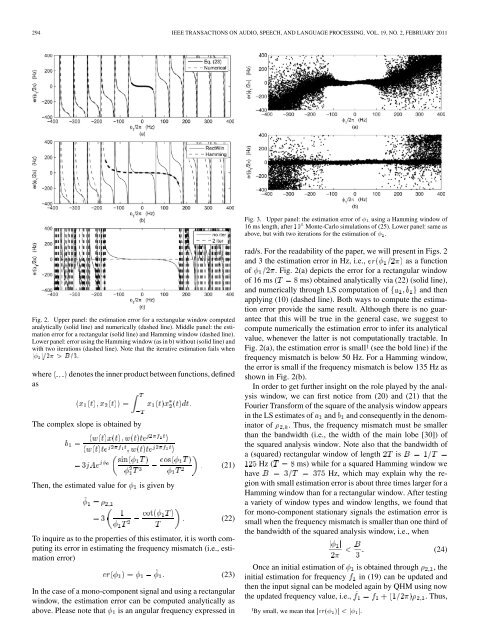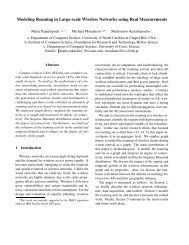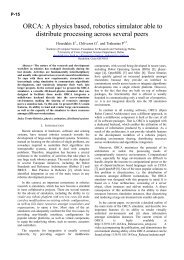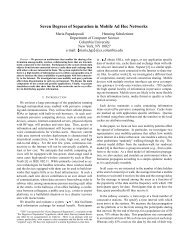Adaptive AM–FM Signal Decomposition With Application to ... - ICS
Adaptive AM–FM Signal Decomposition With Application to ... - ICS
Adaptive AM–FM Signal Decomposition With Application to ... - ICS
Create successful ePaper yourself
Turn your PDF publications into a flip-book with our unique Google optimized e-Paper software.
294 IEEE TRANSACTIONS ON AUDIO, SPEECH, AND LANGUAGE PROCESSING, VOL. 19, NO. 2, FEBRUARY 2011<br />
Fig. 3. Upper panel: the estimation error of using a Hamming window of<br />
16 ms length, after 10 Monte-Carlo simulations of (25). Lower panel: same as<br />
above, but with two iterations for the estimation of .<br />
Fig. 2. Upper panel: the estimation error for a rectangular window computed<br />
analytically (solid line) and numerically (dashed line). Middle panel: the estimation<br />
error for a rectangular (solid line) and Hamming window (dashed line).<br />
Lower panel: error using the Hamming window (as in b) without (solid line) and<br />
with two iterations (dashed line). Note that the iterative estimation fails when<br />
j j=2 > B=3.<br />
where<br />
as<br />
denotes the inner product between functions, defined<br />
The complex slope is obtained by<br />
Then, the estimated value for<br />
is given by<br />
(21)<br />
(22)<br />
To inquire as <strong>to</strong> the properties of this estima<strong>to</strong>r, it is worth computing<br />
its error in estimating the frequency mismatch (i.e., estimation<br />
error)<br />
(23)<br />
In the case of a mono-component signal and using a rectangular<br />
window, the estimation error can be computed analytically as<br />
above. Please note that is an angular frequency expressed in<br />
rad/s. For the readability of the paper, we will present in Figs. 2<br />
and 3 the estimation error in Hz, i.e., as a function<br />
of . Fig. 2(a) depicts the error for a rectangular window<br />
of 16 ms ( ms) obtained analytically via (22) (solid line),<br />
and numerically through LS computation of and then<br />
applying (10) (dashed line). Both ways <strong>to</strong> compute the estimation<br />
error provide the same result. Although there is no guarantee<br />
that this will be true in the general case, we suggest <strong>to</strong><br />
compute numerically the estimation error <strong>to</strong> infer its analytical<br />
value, whenever the latter is not computationally tractable. In<br />
Fig. 2(a), the estimation error is small 1 (see the bold line) if the<br />
frequency mismatch is below 50 Hz. For a Hamming window,<br />
the error is small if the frequency mismatch is below 135 Hz as<br />
shown in Fig. 2(b).<br />
In order <strong>to</strong> get further insight on the role played by the analysis<br />
window, we can first notice from (20) and (21) that the<br />
Fourier Transform of the square of the analysis window appears<br />
in the LS estimates of and and consequently in the denomina<strong>to</strong>r<br />
of . Thus, the frequency mismatch must be smaller<br />
than the bandwidth (i.e., the width of the main lobe [30]) of<br />
the squared analysis window. Note also that the bandwidth of<br />
a (squared) rectangular window of length is<br />
Hz ( ms) while for a squared Hamming window we<br />
have<br />
Hz, which may explain why the region<br />
with small estimation error is about three times larger for a<br />
Hamming window than for a rectangular window. After testing<br />
a variety of window types and window lengths, we found that<br />
for mono-component stationary signals the estimation error is<br />
small when the frequency mismatch is smaller than one third of<br />
the bandwidth of the squared analysis window, i.e., when<br />
(24)<br />
Once an initial estimation of is obtained through , the<br />
initial estimation for frequency in (19) can be updated and<br />
then the input signal can be modeled again by QHM using now<br />
the updated frequency value, i.e.,<br />
. Thus,<br />
1 By small, we mean that jer( )j < j j.
















